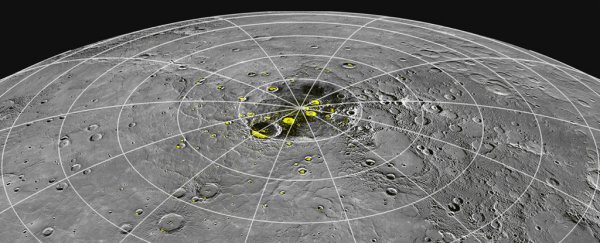Mercury has a reputation, one largely informed by where it exists - closer to the Sun than any other planet in the Solar System. That unforgiving proximity means Mercury gets hot. Really hot.
Daytime temperatures on Mercury can reach a scorching 430 °Celsius (800 °Fahrenheit), but they also plummet to –180 °C (–290 °F) at night. Then, there are the places on Mercury where the Sun don't shine, ever.
At its poles, Mercury - like the Moon - has what are called 'permanently shadowed regions' (PSRs): cratered recesses that exist in a state of eternal darkness, despite being relatively close to the Sun.
In the 1990s, ground-based radar observations of Mercury began to pick up abnormal readings inside these pitch-black PSRs, but it wasn't until NASA's MESSENGER spacecraft visited the planet in 2011 that we had a chance to confirm what these abnormalities really were: deposits of water ice, forever frozen in unshifting shadow.
If it sounds ironic that water ice perpetuates indefinitely on such a hellishly hot world, that's perfectly understandable. Nonetheless, the phenomenon is explainable: asteroids, comets, and meteorites can deliver ice when they crash onto the surfaces of planets, and if these ice deliveries end up in the dark craters, they never see sunlight, and never get a chance to thaw.
No, the true irony lies in something else. In a new study, scientists propose that at least some of Mercury's ice is actually produced because of the extreme, punishing heat the small planet endures in the rays of our Sun.
It may sound bizarre, but according to a team from the Georgia Institute of Technology, it's a well-known phenomenon.
"This is not some strange, out-of-left-field idea," explains chemist Brant Jones, the co-investigator of Georgia Tech's REVEAL lab (Radiation Effects on Volatiles and Exploration of Asteroids and Lunar Surfaces).
"The basic chemical mechanism has been observed dozens of times in studies since the late 1960s."
In the team's new paper, the researchers use modelling to explore how this chemical mechanism could take place on Mercury, in a continuous water formation process that relies on minerals in the planet's surface soil and a process called recombinative desorption (RD).
The soil minerals contain metal oxides, which are bombarded by charged proton particles carried on the solar wind, resulting in the formation of bound hydroxyls, molecular hydrogen, and water. In the airless environment, and under extreme heat, H20 molecules would be freed from the surface soil, diffusing and drifting across Mercury's atmosphere-less environment.
If any such water molecules happen to drift into Mercury's perma-shadows, they likely will freeze there, and never see the light of day again.
"Water formed from this mechanism will inevitably amass in the cold PSRs and will contribute significant amounts to the surface of Mercury over geological time periods," the researchers explain in their paper.
Overall, ice deliveries from asteroids and meteorites would still account for the vast majority of Mercury's polar ice, the team says, but the planet's secret ice factory could still output a huge amount of product.
"The total amount that we postulate that would become ice is 10^^13 kilograms (10,000,000,000,000 kilograms or 10,000,000,000 tonnes) over a period of about 3 million years," Jones says.
"The process could easily account for up to 10 percent of Mercury's total ice."
Not bad at all, for a hot little hellscape adjacent to the Sun. And for human purposes, in terms of future space exploration and planetary colonisation (if not ever Mercury), the same chemical processes could point a way to finding water in environments that otherwise aren't known for having any.
"Significant amounts of water synthesised from RD can contribute to not only on the surface of Mercury but on other airless bodies that have been implanted with solar-wind protons and undergone a significant thermal excursion," the researchers say.
"This would make RD a generally significant but unrecognised source term for molecular water production on several Solar System bodies."
The findings are reported in Astrophysical Journal Letters.
